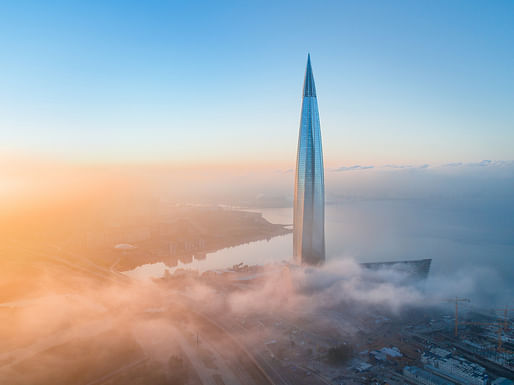

Local officials in Saint Petersburg, Russia have granted the RMJM-designed Lakhta Center Multifunctional Complex the authorization for commissioning of the facility after it passed final inspections this week.
While the grand opening as Gazprom's new HQ is still another year out, the 462-meter/1,516-foot tower is already holding the title of Europe's tallest building, the world's northernmost skyscraper, and sporting the fastest elevators in Russia (wheee!).
The list of remaining tasks before the Center can officially open to the public is still quite impressive, as the announcement lays out:
"The
final preparation of the business and public space by operators and
tenants will take at least a year: completion of the finishing,
fit-out of the premises, installation of equipment and improvement
works.
"In the meantime the following will be prepared for reception
of visitors: the highest panoramic restaurant in Europe at the level
of 315 meters and a sky deck at the mark of 360 meters, a modern
spherical planetarium with the sky panorama including 10 mln. stars,
sports facilities with a panoramic swimming pool, an educational
center for children and youth, exhibition space, an amphitheater on
the coast, a concert hall with the possibility of 15 transformations
and open space for wide audience forming a new environment of the
global level.
"Within the same time the related structures are
to complete the fit-out of the embankments and connection of the
complex to the street and road network to which end two elevated
roads with a dedicated cycle-pedestrian sidewalk were built across
Lakhta harbor.
"The date of opening of the complex will be determined by the moment of full readiness of the complex for reception of employees and visitors."
More engineering details from the project description:
"The foundations of the complex facilities are a work of construction art. The area of the raft foundation of the Multifunctional building is more than 2 hectares. The box-shaped foundation of the Lakhta Center tower consists of three slabs, the lower one being an absolute monolith 3,600 m high with the volume of 19,624 sq. m. The pouring was carried out by the builders simultaneously within 49 hours, which became a world record."
"One of the most complicated issues related with the erection of the complex appeared to be the wind. At elevations it is much stronger than the ground wind: the builders recorded wind blasts from 120 to 140 km/hour, which is the highest wind strength level according to the Beaufort scale. The storm warnings forced to stop the work of cranes and people on open structures. There were 159 storm warnings in 2015, 258 in 2016, and 176 in 2017; the operation of installation of the final spire structure most heavily dependent on the weather accounted for 18 days with strong wind. Nevertheless, the construction was completed on time."
"The climatic conditions were taken into account during the complex design and construction. The most complicated task was development of the antiicing system of the tower based on scientific developments and two series of trials in Russia and Canada. Passive protection is the spire façade consisting of a grid decreasing windage and preventing formation of the ice or snow sheet in the spire zone. The active protection comes into action when required and actuates the heating elements laid on certain sections of the spire profile. This system has no analogs in the world."
2 Comments
It is about time for Russia to recognize the value of good architecture.
So far, so good!
cant imagine working so high with those winds....
Block this user
Are you sure you want to block this user and hide all related comments throughout the site?
Archinect
This is your first comment on Archinect. Your comment will be visible once approved.